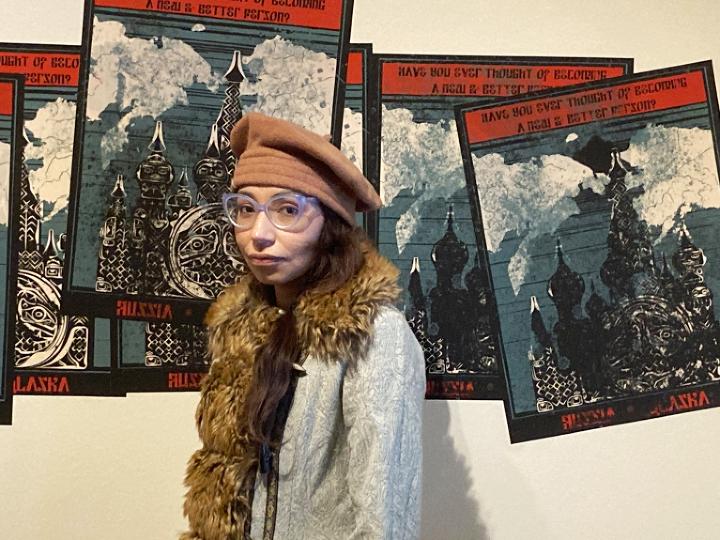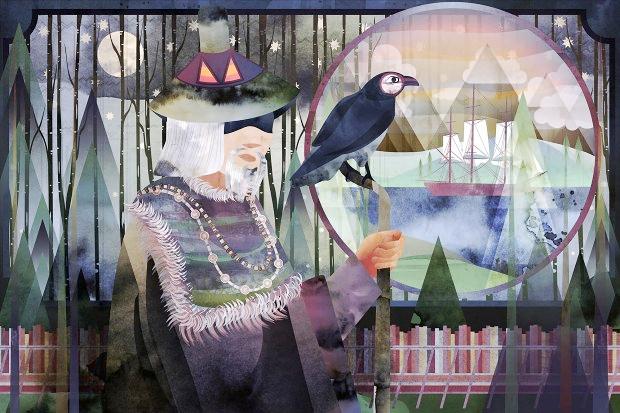 |
Canku Ota
|
 |
|
(Many Paths)
|
||
|
An Online Newsletter
Celebrating Native America
|
||
|
February 2021 - Volume
19 Number 2
|
||
|
|
||
|
St. Paul Artist Marlena
Myles Celebrates Her Native Heritage And Shares Little-known History
In First Solo Exhibit
|
||
|
by Kathy
Berdan - Pioneer Press
|
||
It's not unusual for St. Paul-based artist Marlena Myles' work to be shown in museums. Her digital art, built on her Native heritage, has been exhibited at Minneapolis Institute of Art, the Minnesota Museum of American Art and the Red Cloud Heritage Center in Pine Ridge, S.D. The Twin Cities saw her animated piece "Innerworld Prism" in a big way recently — projected on Highlight Tower in Northeast Minneapolis as part of the Great Northern Festival. What might seem unusual is the location of Myles' first solo exhibit: The Museum of Russian Art in Minneapolis. "People don't think about Russians interacting with Natives," Myles said in a recent interview. In fact, she said, the United States' purchase of Alaska "is an untold part of American history — basically a paragraph in books." As the museum describes her exhibit: "These digitally created works bring to light the commonly unknown history of interactions between Russian explorers, settlers, traders, clergy, and Alaska Natives before the Alaskan territory was sold to the United States in 1867. These are important reflections, much needed in the contemporary United States and Minnesota, that acknowledge Indigenous histories." Myles (Dakota, Mohegan, Muscogee), 35, says she hopes her works get people to see what they have in common and "compare their own history, whether they're Indigenous, Russian or other immigrant." She wants her work to bring new Native audiences to the museum. Myles' creations in "Dynamics of Russian Colonialism in Alaska" range from dark, shimmering pieces to images of Native saints and battles. There are exquisite nature cutouts that create shadows laid over Russian and Alutiiq (Aleut) words, spirit animals and an animated story in the language of the Russian Alaska Native village of Ninilchik. All of them were done in the past couple of months, says Myles, who prefers working on a tight deadline.
Half of the pieces in the Russian exhibit are printed on metal. Myles says metal captures the digital feel of her work. "It's smooth like a computer screen," she says. Mark Meister, who started as executive director at TMORA in 2019, says one of his goals for the museum is to engage with the community. Most people don't know about the Russian/Native connection in Alaska, he says.
Myles says her interest in Russia comes from a shared history of oppression. The interactions between Russians and Alaskan Natives reminded her of "interactions between Europeans and my own people in the early days of Minnesota history," she says in the exhibit's artist statement. The museum director received a Minnesota State Arts Board Cultural Community Partnership Grant to fund the project. The descriptions and labels for the exhibit are "all her words," Meister says of Myles' exhibition. Myles works from home in St. Paul's West Seventh neighborhood in a spare bedroom, creating her work on the computer. She's a self-taught artist. Most classes teaching digital art are out of date in five years, she says. Digital artists are willing to share their techniques, Myles says, because they're learning all the time. And there's no messy cleanup. When Myles paints at home, there are brushes and canvas and paint spatters. "I like the convenience and efficiency (of digital art-making)," she says. "It's what I strive for in life." She says she does a lot of her work late at night when there are fewer distractions: "I'm in my own world when I work at home." Myles was born in Connecticut and the family moved to the Twin Cities in 1992. A single mother, her mom moved her four children to Rapid City, S.D., for middle and high school. — away from gang influences and big city problems in the late 1990s. None of them liked the small town, Myles says, and they all returned to the Twin Cities after completing school.
Before she became a full-time artist, Myles worked in customer service at a hotel for a time after the return. She says she liked anticipating guests' needs before they asked, but she didn't like the co-workers, emotions and drama. She first exhibited her work in 2014. Myles' mother, who does beadwork her daughter says could be shown in a museum, spoke Dakota as her first language growing up in Spirit Lake, N.D. Myles is learning the language as an adult and is starting a Dakota book publishing business that will focus on children's books. She has illustrated children's books including "Thanku: Poems of Gratitude," "Kikta wo / Kikta ye!" and "Indian No More" (winner of the 2020 American Indian Youth Literature Award for best middle grade novel). Myles' passion for the culture of her people has also taken her into fashion. She designs Native print material because she felt Native fabrics "weren't appealing. They weren't by Natives." "I want to see our art evolve into modern times," she says. She wants her art to educate. "For Native Americans, the American history they teach you in school doesn't apply today," Myles says. "Dynamics of Russian Colonialism in Alaska"
|
||||||||
|
|
|
|
||
|
|
||
| Canku Ota is a free Newsletter celebrating Native America, its traditions and accomplishments . We do not provide subscriber or visitor names to anyone. Some articles presented in Canku Ota may contain copyright material. We have received appropriate permissions for republishing any articles. Material appearing here is distributed without profit or monetary gain to those who have expressed an interest. This is in accordance with Title 17 U.S.C. Section 107. | ||
|
Canku Ota is a copyright ©
2000 - 2021 of Vicki Williams Barry and Paul Barry.
|
||
 |
 |
|
|
The "Canku
Ota - A Newsletter Celebrating Native America" web site and
its design is the
|
||
|
Copyright ©
1999 - 2021 of Paul C. Barry.
|
||
|
All Rights Reserved.
|
||



